#emil doepler
Explore tagged Tumblr posts
Text

The Semnones' Grove of Fetters by Emil Doepler (1905)
118 notes
·
View notes
Text

Emil Doepler Freya driving her cat chariot 1905
55 notes
·
View notes
Text
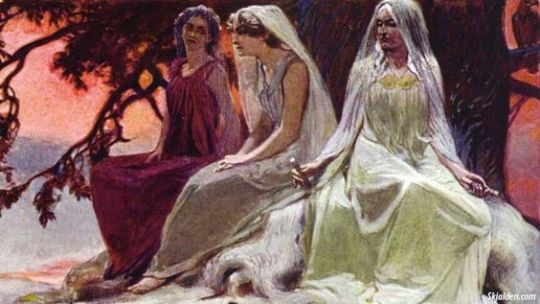
Emil Doepler- The Norns
66 notes
·
View notes
Text
“Will the modern world follow this fatal course right to the end, or will a new readjustment intervene once more, as it did in the case of the Greco-Latin decadence, before it reaches the bottom of the abyss into which it is being drawn? It would seem that a halt midway is no longer possible since, according to all the indications furnished by the traditional doctrines, we have in fact entered upon the last phase of the Kali-Yuga, the darkest period of this “dark age”, the state of dissolution from which it is impossible to emerge otherwise than by a cataclysm, since it is not a mere readjustment that is necessary at such a stage, but a complete renovation.
Disorder and confusion prevail in every domain and have been carried to a point far surpassing all that has been known previously, so that, issuing from the West, they now threaten to invade the whole world; we know full well that their triumph can never be other than apparent and transitory, but such are the proportions which it has reached, that it would appear to be the sign of the gravest of all the crises through which mankind has passed in the course of its present cycle. Have we not arrived at that terrible age, announced in the Sacred Books of India, “when the castes shall be mingled, when even the family shall no longer exist”?
It is only necessary to look around in order to be convinced that this state is truly that of the world of today, and to see on all sides that profound degeneracy which the Gospel terms “the abomination of desolation”. The gravity of the situation cannot be minimized; it should be envisaged such as it is, without optimism but also without pessimism, for as we have already said, the end of the old world will be also the beginning of a new one.
(...)
the point at which the “descent” is completely accomplished, where “the wheel stops turning”—at least for the instant marking the passage from one cycle to another—it is necessary to conclude that, until this point is actually attained, it is impossible that these things should be understood by men in general, but only by the small number of those who are destined to prepare, in one way or in another, the germs of the future cycle.”
― René Guénon, The Essential René Guénon: Metaphysical Principles, Traditional Doctrines, and the Crisis of Modernity

After Ragnarök by Emil Doepler (1855–1922)
#rene guenon#the crisis of modernity#kali yuga#the end of the world#the beginning of a new world#new creation#perennial philosophy#after ragnarök#emil doepler
7 notes
·
View notes
Text
Interesting post about costume here.
This paragraph in particular caught my attention...
What we think of as “peasant garb” is actually the product of a game of telephone that travels back from Romantic Revival art, and many of those (urban) artists got their idea of what rural peasants wore from opera costumes. The costumers working at the opera were not going out to the country side to take notes on what farmers actually wore, nor did they want to. Opera is show biz, you want it to be evocative, but not ordinary. Their costumes would have been based on what urban folks were wearing, with extra little touches like a shepherds crook to make it look “rural”.
... because it was Wagner's Ring Cycle that gave us horned helmets.
They didn't originate with the Vikings. They originated with the 1876 costume designs for a bunch of operas, and those designs by Carl Emil Doepler still exist.
For reference, all the horny characters are mortals.
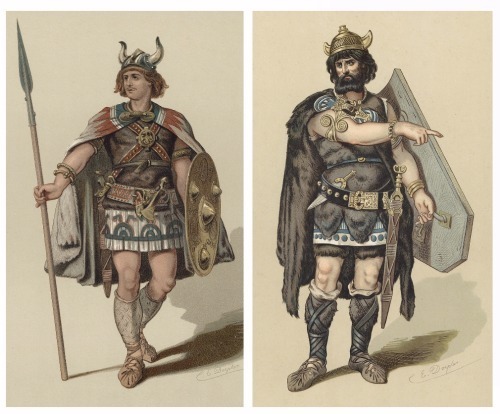

Those helmets were probably based on archaeological finds, even though all Northern European examples are, AFAIK and depending on context, either religious headgear equivalent to a bishop's mitre, or ceremonial headgear equivalent to a crown.
In addition, every single one predates the Viking Age by a period ranging from a couple of centuries to a couple of millennia so - makes vague handwave gesture - they're more appropriate for the sorta-kinda mythic Migration Era setting of the Ring than any Vik who ever inged..
Doepler's designs also feature WINGED helmets, worn by immortals like Wotan...
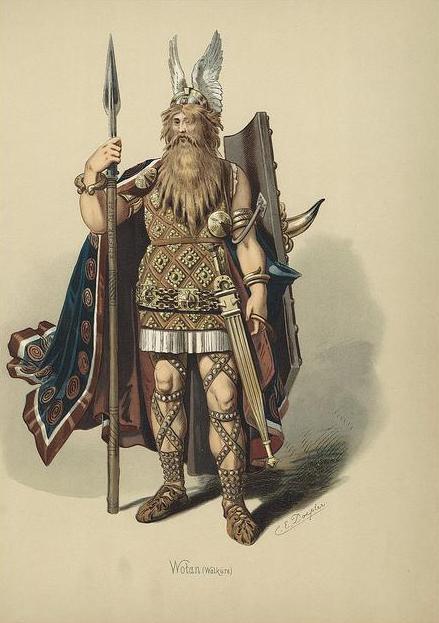
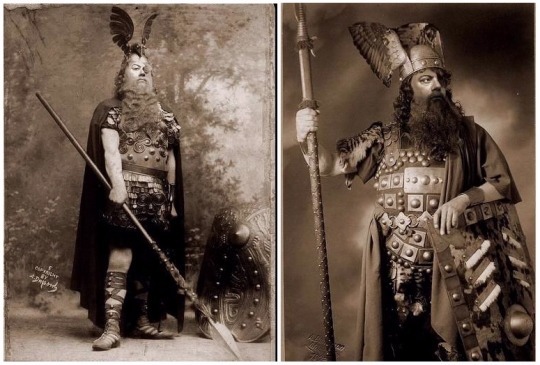
... and the Valkyries.
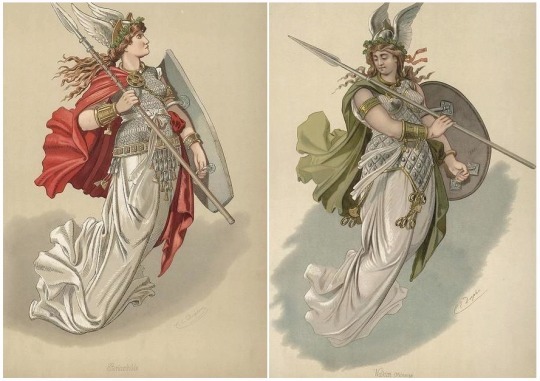


Something else I encountered when looking for pics to illustrate this was that other clichéd armour error, the boob-plate.
Here's dramatic soprano Karin Branzell wearing one...
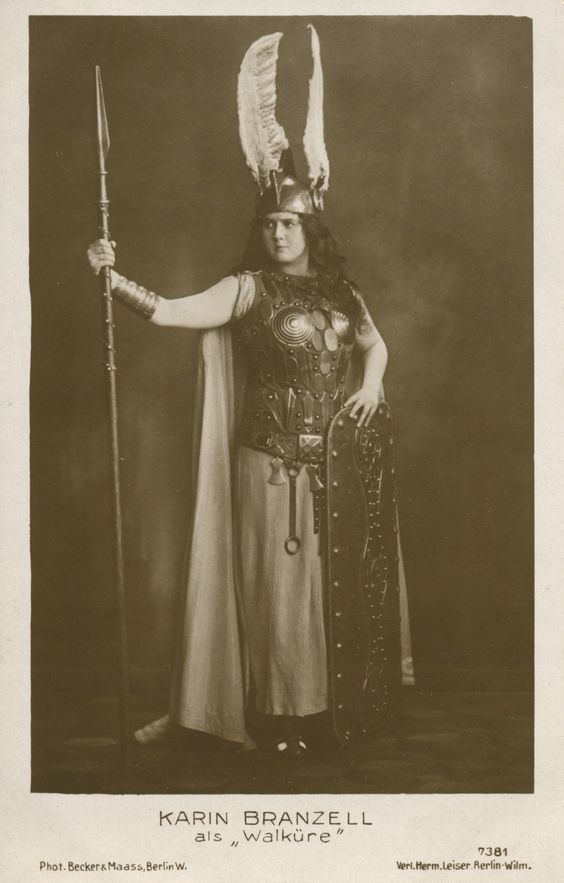
...while here's heroic tenor Fritz Vogelstrom also wearing one.
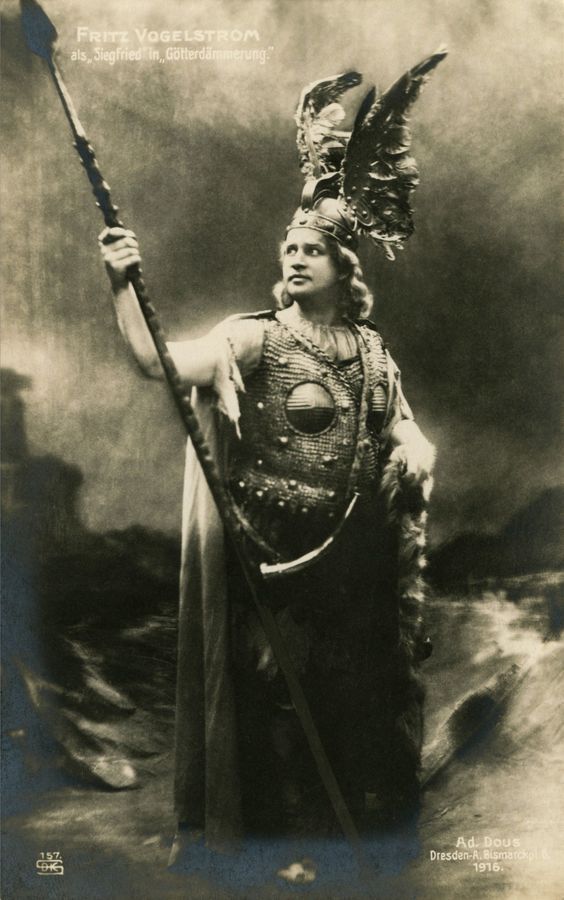
He's singing the role of Siegfried but wearing the costume of Brunnhilde, at least that's how it looks to an operatic Philistine like me.
Anyway...
Winged helmets are even more historically dodgy - no archaeological evidence at all - yet are actually more feasible as working combat helmets.
The difference is that horns, being heavy, need sturdy mountings so a horned helmet both provides catch-points for incoming blows and handles for an enemy to grapple, while a winged helmet does neither. The wings, being light, wouldn't need solid fixtures so would just shear off under a weapon or come off in an enemy's hands.
I'm well aware that other times, places and cultures - Indo-Persia, Poland, Japan etc. - had helmets with wings, horns and all sorts of other stuff, but this is about how the popular image of Vikings that headgear came from opera.
And went all over the place... :->



156 notes
·
View notes
Text
My favorite classic depictions of Yngvi-Freyr

Frey mounts the height of Hlidskjalf, Katharine Pyle (1930)

Sir Edward Cooley Burne-Jones (1881)

Freyr exchanges his sword for Gerd, Lorenz Frølich (1895)

The Lovesickness of Frey, W.G. Collingwood ( (1908)

Freyr Riding Gullinbursti, Ludwig Pietsch (1865)

Lorenz Frølich (1845)

Freyr and Skirnir, Carl Emil Doepler, Sr. (1876)

Freyr rides to the wood Barri to meet Gerda, C.E. Brock (1930)

Carl Emil Doepler (1905)

Alexander Zick (1901)

Freyr Sitting on Odin's Seat, Maria Klugh (1909)

Freyr and Gerd, Lorenz Frølich (1885)

Freyr, Ruler of Alfheim - Freyr and the Elves, C.E. Brock (1930)

Freyr seated on the throne of Odin, E. E. Speight (1903)

Freyr and Freyja, Donn T. Crane (1920)
#hail Freyr#art#my favorites#history#classical art#heathenry#norse paganism#polytheism#norse polytheism#deity work#deity worship#paganism#pagan#norse mythology#norse gods#norse myth#freyr#norse pantheon
61 notes
·
View notes
Text



A collection of some of my favorite 19th & 20th-century art of mythological scenes:
Emil Doepler | Loki's Brood (1905)
James Doyle Penrose | Freya and Her Necklace (1890)
Emil Doepler | Nerthus on Her Cart (1905)
#norse paganism#norse mythology#norse pagan#norse gods#pagan#heathenry#paganism#heathen#germanic goddesses#germanic paganism#germanic mythology#hel#goddess hel#angrboda#fenrir#jormundgandr#freya#freyja#nerthus#nerþus#art
52 notes
·
View notes
Text




The 'Odin' from Lejre 900 CE. Note the two birds, possibly Huginn and Muninn. Also the two animal faces behind, possibly the wolves Geri and Freki. I included an illustration of Odin by Carl Emil Doepler from 1882. It's very similar in style to this object that was only discovered in 2009. Images from kokita-eri-historiadelarte blogspot and Ole Mallin @ Roskilde Museum.
"In his [Archbishop Unni's] days the Hungarians devastated not only our Saxony and the other provinces on this side of the Rhine but also Lotharingia and Francia across the Rhine. The Danes, too, with the Slavs as allies, plundering first of all the Transalbingian Saxons and then ravaging the country this side of the Elbe, made Saxony tremble in great terror. Over the Danes there ruled at that time Harthacanute Gorm, a savage worm, I say, and not moderately hostile to the Christian people. He set about completely to destroy Christianity in Denmark, driving the priests of God from its bounds and also torturing very many of them to death."
-Adam of Bremen. History of the Archbishops of Hamburg-Bremen (Records of Western Civilization Series) (p. 62). Columbia University Press.
#denmark#germanic#european art#europe#odin#archaeology#vikings#middle ages#medieval literature#medieval history#medieval art#artifacts#history#statue#sculpture#pagan
30 notes
·
View notes
Text
The origin of the horned Viking helmet

The Vikings are stereotypically imagined as brutal warriors with horned helmets. However no historic images exist of “Norsemen with horned helmets”. And we have found plenty of helmets from that era and none of them have horns. So where does the idea come from?
During German Romanticism, Wagner wrote his four opera’s making up Der Ring des Nibelungen. To perform the opera’s there needs to be stages, props, famous singers for the opening night and… costumes.
Carl Emil Doepler was a Polish born German artist who specialized in illustrations for books and newspapers but was also a costume designer. After having met Richard Wagner, he was asked to design the costumes for the opera’s.
Doepler didn’t conduct any research to Germanic dress, and consistent with the Romantic era, he choose designs that speak to one’s emotions, rather than a “set academic/artistic standard”.
The opera’s themselves were a huge hit with the Bayreuther crowd and Germany. Besides the praise for the opera’s stories, music and leitmotivs, Doepler was praised for his designs. He would make many illustrations of Nordic figures which all were held in high regard.
When people talked about Vikings, the only image that would come to mind -because it was pretty much the only one there was- were people in horned helmets, helmets with wings, big wooden shields and armor on. Because that was the reference point people had.
It’s kind of similar to thinking that the MCU’s rendition of Vikings and Germans is historically accurate, but it spoke to people’s minds. And it stuck.
Carl Emil Doepler, “Odin on Hildskjalf” 18th century, Germany.
(Aka the most famous drawing of Odin on the internet)
#frankish#merovingian#viking archaeology#archaeology#carolingian#charlemagne#field archaeology#viking mythology#merovingian archaeology#germanic mythology#norse mythology#anglo saxon#field archaeologist#frisian#odin#viking#vikings#germanic#germanic folklore#germanic archaeology#wodan#anglo saxon archaeology#history#jewelry#norse
100 notes
·
View notes
Text

Escena de Ragnarök, la batalla final entre Thor y Jörmungandr. Ilustración de Emil Doepler para el libro: “Walhall, die Götterwelt der Germanen” Martin Oldenbourg, Berlín, pág. 56, publicado en el año 1905.
25 notes
·
View notes
Text
Back to writing non-poem stuff for now
13 notes
·
View notes
Text

The Volva by Emil Doepler, 1905.
16 notes
·
View notes
Text
Fate Grand Order Servant Comparisons
Cú Chulainn

Left - FGO
Right - illustration by J. C. Leyendecker in T. W. Rolleston's Myths & Legends of the Celtic Race, 1911

Left - FGO
Right - Carl Emil Doepler made in 1880.
Note: Caster Cu Chulainn is a Pseudo-Servant of Odin
#fate grand order#fgo#cu chulainn#cu chulainn fgo#fgo cu chulainn#fate series#fate stay night#fate cu chulainn#cu chulainn fate#fate extella#caster cu chulainn
11 notes
·
View notes
Text
So I've suddenly decided:
"hey wouldn't it be fun to start making paintings and pictures of Norse mythology a little aesthetic?"
That's exactly what I'll be doing! Of course credits to the artists so you can go find the original :)
✧・゚: *✧・゚:*.・゜゜・✧・゚: *✧・゚:*
We are starting it of with Freya!
‼️Slight nudity ahead‼️
༶•┈┈♢┈♡Freyja♡┈♢┈┈•༶
James Doyle Penrose (1862-1932)
"Freyja and the Necklace"

Nils jakob Blommèr (1847)
"Heimdall returns the necklace Bryfing to Freya"

John Bauer (1905)
"Freya"

Emil Doepler (1905)
"Freyja and her cheriot pulled by cats"

John bauer (1911)
"Freyja Greets Svipdag"

Donn T. Crane (1920)
"Freyr & Freyja with Boar & Cats"

Harry George Theaker 1920
"Freya and the Dwarves"

10 notes
·
View notes

